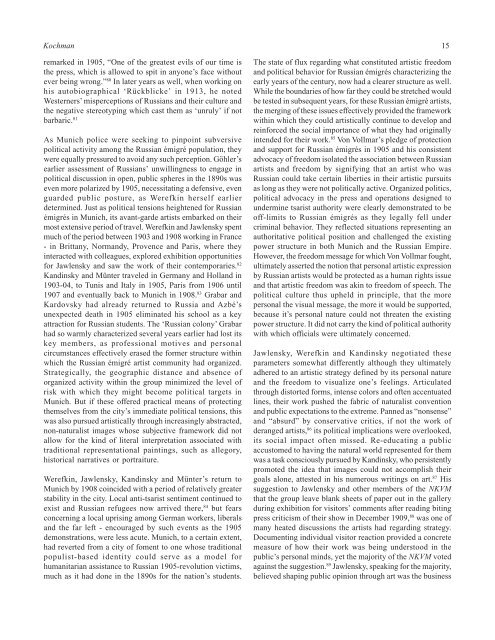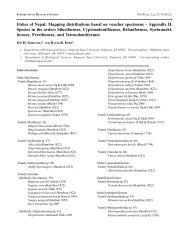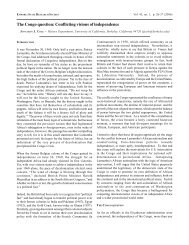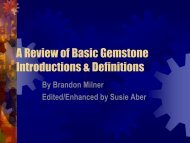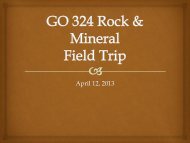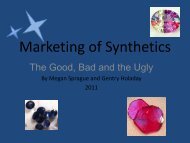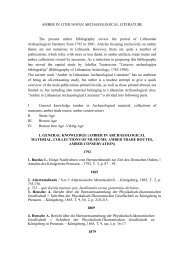Russian émigré artists and political opposition in fin-de-siècle Munich
Russian émigré artists and political opposition in fin-de-siècle Munich
Russian émigré artists and political opposition in fin-de-siècle Munich
- No tags were found...
Create successful ePaper yourself
Turn your PDF publications into a flip-book with our unique Google optimized e-Paper software.
Kochman 15remarked <strong>in</strong> 1905, “One of the greatest evils of our time isthe press, which is allowed to spit <strong>in</strong> anyone’s face withoutever be<strong>in</strong>g wrong.” 80 In later years as well, when work<strong>in</strong>g onhis autobiographical ‘Rückblicke’ <strong>in</strong> 1913, he notedWesterners’ misperceptions of <strong>Russian</strong>s <strong>and</strong> their culture <strong>and</strong>the negative stereotyp<strong>in</strong>g which cast them as ‘unruly’ if notbarbaric. 81As <strong>Munich</strong> police were seek<strong>in</strong>g to p<strong>in</strong>po<strong>in</strong>t subversive<strong>political</strong> activity among the <strong>Russian</strong> <strong>émigré</strong> population, theywere equally pressured to avoid any such perception. Göhler’searlier assessment of <strong>Russian</strong>s’ unwill<strong>in</strong>gness to engage <strong>in</strong><strong>political</strong> discussion <strong>in</strong> open, public spheres <strong>in</strong> the 1890s waseven more polarized by 1905, necessitat<strong>in</strong>g a <strong>de</strong>fensive, evenguar<strong>de</strong>d public posture, as Werefk<strong>in</strong> herself earlier<strong>de</strong>term<strong>in</strong>ed. Just as <strong>political</strong> tensions heightened for <strong>Russian</strong><strong>émigré</strong>s <strong>in</strong> <strong>Munich</strong>, its avant-gar<strong>de</strong> <strong>artists</strong> embarked on theirmost extensive period of travel. Werefk<strong>in</strong> <strong>and</strong> Jawlensky spentmuch of the period between 1903 <strong>and</strong> 1908 work<strong>in</strong>g <strong>in</strong> France- <strong>in</strong> Brittany, Norm<strong>and</strong>y, Provence <strong>and</strong> Paris, where they<strong>in</strong>teracted with colleagues, explored exhibition opportunitiesfor Jawlensky <strong>and</strong> saw the work of their contemporaries. 82K<strong>and</strong><strong>in</strong>sky <strong>and</strong> Münter traveled <strong>in</strong> Germany <strong>and</strong> Holl<strong>and</strong> <strong>in</strong>1903-04, to Tunis <strong>and</strong> Italy <strong>in</strong> 1905, Paris from 1906 until1907 <strong>and</strong> eventually back to <strong>Munich</strong> <strong>in</strong> 1908. 83 Grabar <strong>and</strong>Kardovsky had already returned to Russia <strong>and</strong> Azbé’sunexpected <strong>de</strong>ath <strong>in</strong> 1905 elim<strong>in</strong>ated his school as a keyattraction for <strong>Russian</strong> stu<strong>de</strong>nts. The ‘<strong>Russian</strong> colony’ Grabarhad so warmly characterized several years earlier had lost itskey members, as professional motives <strong>and</strong> personalcircumstances effectively erased the former structure with<strong>in</strong>which the <strong>Russian</strong> <strong>émigré</strong> artist community had organized.Strategically, the geographic distance <strong>and</strong> absence oforganized activity with<strong>in</strong> the group m<strong>in</strong>imized the level ofrisk with which they might become <strong>political</strong> targets <strong>in</strong><strong>Munich</strong>. But if these offered practical means of protect<strong>in</strong>gthemselves from the city’s immediate <strong>political</strong> tensions, thiswas also pursued artistically through <strong>in</strong>creas<strong>in</strong>gly abstracted,non-naturalist images whose subjective framework did notallow for the k<strong>in</strong>d of literal <strong>in</strong>terpretation associated withtraditional representational pa<strong>in</strong>t<strong>in</strong>gs, such as allegory,historical narratives or portraiture.Werefk<strong>in</strong>, Jawlensky, K<strong>and</strong><strong>in</strong>sky <strong>and</strong> Münter’s return to<strong>Munich</strong> by 1908 co<strong>in</strong>ci<strong>de</strong>d with a period of relatively greaterstability <strong>in</strong> the city. Local anti-tsarist sentiment cont<strong>in</strong>ued toexist <strong>and</strong> <strong>Russian</strong> refugees now arrived there, 84 but fearsconcern<strong>in</strong>g a local upris<strong>in</strong>g among German workers, liberals<strong>and</strong> the far left - encouraged by such events as the 1905<strong>de</strong>monstrations, were less acute. <strong>Munich</strong>, to a certa<strong>in</strong> extent,had reverted from a city of foment to one whose traditionalpopulist-based i<strong>de</strong>ntity could serve as a mo<strong>de</strong>l forhumanitarian assistance to <strong>Russian</strong> 1905-revolution victims,much as it had done <strong>in</strong> the 1890s for the nation’s stu<strong>de</strong>nts.The state of flux regard<strong>in</strong>g what constituted artistic freedom<strong>and</strong> <strong>political</strong> behavior for <strong>Russian</strong> <strong>émigré</strong>s characteriz<strong>in</strong>g theearly years of the century, now had a clearer structure as well.While the boundaries of how far they could be stretched wouldbe tested <strong>in</strong> subsequent years, for these <strong>Russian</strong> <strong>émigré</strong> <strong>artists</strong>,the merg<strong>in</strong>g of these issues effectively provi<strong>de</strong>d the frameworkwith<strong>in</strong> which they could artistically cont<strong>in</strong>ue to <strong>de</strong>velop <strong>and</strong>re<strong>in</strong>forced the social importance of what they had orig<strong>in</strong>ally<strong>in</strong>ten<strong>de</strong>d for their work. 85 Von Vollmar’s pledge of protection<strong>and</strong> support for <strong>Russian</strong> <strong>émigré</strong>s <strong>in</strong> 1905 <strong>and</strong> his consistentadvocacy of freedom isolated the association between <strong>Russian</strong><strong>artists</strong> <strong>and</strong> freedom by signify<strong>in</strong>g that an artist who was<strong>Russian</strong> could take certa<strong>in</strong> liberties <strong>in</strong> their artistic pursuitsas long as they were not <strong>political</strong>ly active. Organized politics,<strong>political</strong> advocacy <strong>in</strong> the press <strong>and</strong> operations <strong>de</strong>signed toun<strong>de</strong>rm<strong>in</strong>e tsarist authority were clearly <strong>de</strong>monstrated to beoff-limits to <strong>Russian</strong> <strong>émigré</strong>s as they legally fell un<strong>de</strong>rcrim<strong>in</strong>al behavior. They reflected situations represent<strong>in</strong>g anauthoritative <strong>political</strong> position <strong>and</strong> challenged the exist<strong>in</strong>gpower structure <strong>in</strong> both <strong>Munich</strong> <strong>and</strong> the <strong>Russian</strong> Empire.However, the freedom message for which Von Vollmar fought,ultimately asserted the notion that personal artistic expressionby <strong>Russian</strong> <strong>artists</strong> would be protected as a human rights issue<strong>and</strong> that artistic freedom was ak<strong>in</strong> to freedom of speech. The<strong>political</strong> culture thus upheld <strong>in</strong> pr<strong>in</strong>ciple, that the morepersonal the visual message, the more it would be supported,because it’s personal nature could not threaten the exist<strong>in</strong>gpower structure. It did not carry the k<strong>in</strong>d of <strong>political</strong> authoritywith which officials were ultimately concerned.Jawlensky, Werefk<strong>in</strong> <strong>and</strong> K<strong>and</strong><strong>in</strong>sky negotiated theseparameters somewhat differently although they ultimatelyadhered to an artistic strategy <strong>de</strong>f<strong>in</strong>ed by its personal nature<strong>and</strong> the freedom to visualize one’s feel<strong>in</strong>gs. Articulatedthrough distorted forms, <strong>in</strong>tense colors <strong>and</strong> often accentuatedl<strong>in</strong>es, their work pushed the fabric of naturalist convention<strong>and</strong> public expectations to the extreme. Panned as “nonsense”<strong>and</strong> “absurd” by conservative critics, if not the work of<strong>de</strong>ranged <strong>artists</strong>, 86 its <strong>political</strong> implications were overlooked,its social impact often missed. Re-educat<strong>in</strong>g a publicaccustomed to hav<strong>in</strong>g the natural world represented for themwas a task consciously pursued by K<strong>and</strong><strong>in</strong>sky, who persistentlypromoted the i<strong>de</strong>a that images could not accomplish theirgoals alone, attested <strong>in</strong> his numerous writ<strong>in</strong>gs on art. 87 Hissuggestion to Jawlensky <strong>and</strong> other members of the NKVMthat the group leave blank sheets of paper out <strong>in</strong> the gallerydur<strong>in</strong>g exhibition for visitors’ comments after read<strong>in</strong>g bit<strong>in</strong>gpress criticism of their show <strong>in</strong> December 1909, 88 was one ofmany heated discussions the <strong>artists</strong> had regard<strong>in</strong>g strategy.Document<strong>in</strong>g <strong>in</strong>dividual visitor reaction provi<strong>de</strong>d a concretemeasure of how their work was be<strong>in</strong>g un<strong>de</strong>rstood <strong>in</strong> thepublic’s personal m<strong>in</strong>ds, yet the majority of the NKVM votedaga<strong>in</strong>st the suggestion. 89 Jawlensky, speak<strong>in</strong>g for the majority,believed shap<strong>in</strong>g public op<strong>in</strong>ion through art was the bus<strong>in</strong>ess


